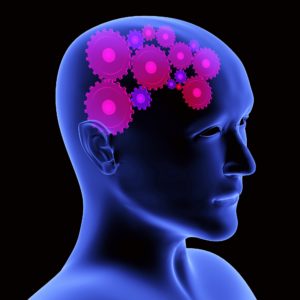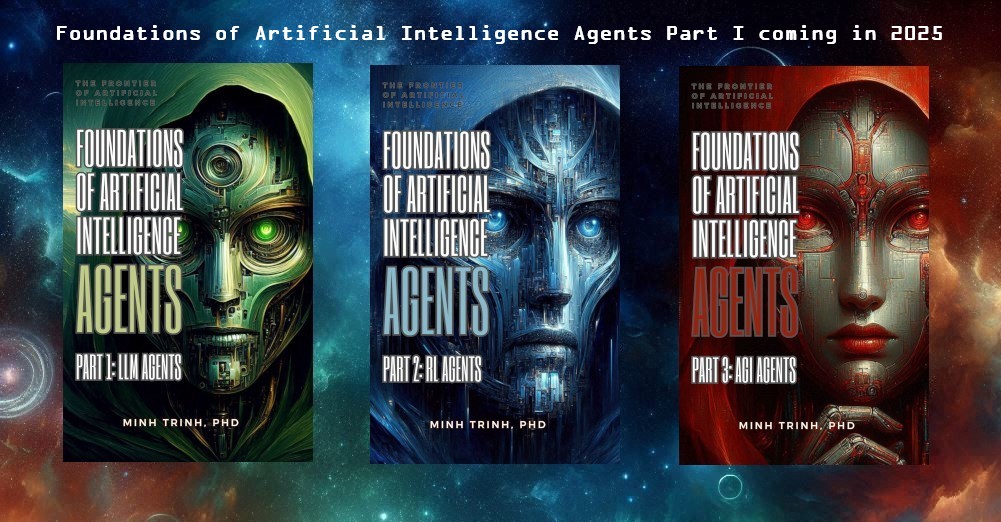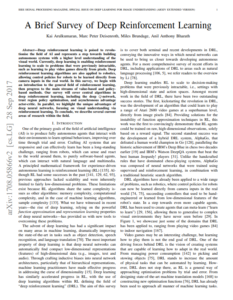This is an economist talk about the implication of machine learning on the workforce by Professor Erik Brynjolfsson at the ICLR 2018 conference. The effect of technology on jobs seems to be very strong on unskilled workers and has been reinforcing inequality. He provides some indications on jobs that will survive AI such as massage therapist and anything that requires human/social interactions.
Introduction to Deep Learning at MIT
This is a short one-week introductory course on Deep Learning at MIT (6.S191). It is a good survey of the field:
It also has an excellent list of reference articles (deep learning papers reading roadmap) in the field. Something that is very useful to quickly access many frequently cited articles.
A Brief Survey of Deep Reinforcement Learning
Deep reinforcement learning is behind the breakthroughs of Alpha Go and the research of Deepmind.
This survey gives a good summary of the field.
Note that the paper Deep Reinforcement Learning: An Overview also summarizes recent research in Deep Reinforcement Learning. It is much longer (70 pages) but maybe more complete.
Meta-Learning and Self-Play
This is a talk by a researcher of Open AI, Ilya Sutskever on meta-learning and self-play. Meta learning is the ability to learn to solve not only one task but also several tasks. Self-play is when a reinforcement learning algorithm plays against itself.
Arxiv Sanity
A great website to sort out research papers in Machine Learning is arxiv sanity. This was developed by Andrej Karpathy now at Tesla. Look at the introductory video:
You can save papers that you like and look for similar papers as ranked by their tf-idf statistics. What is missing is probably a social score of these papers such as which paper is popular at the moment though there are the top saved papers which can serve as a proxy for popularity.
Natural Language Processing with Deep Learning
Communicating and understanding are usually taken as a sign of intelligence and is part of the Turing test. Indeed, the machine needs to communicate and appear to understand the questions of the interrogator to appear human and pass the test. Natural Language Processing (NLP) has made great progress in the past 20 years. Stanford has an excellent course (CS224d) on Natural Language Processing with Deep Learning taught by Chris Manning and Richard Socher (now at Salesforce). It is available here:
The course material is also online here.
An interesting criticism of machine translation engines such as Google Translate (and that use techniques taught in these NLP lectures) appears in the article The Shallowness of Google Translate from the Atlantic.
Machine Learning: an Applied Econometric Approach
Susan Athey’s article discussed machine learning and causal inference. The article Machine learning: an applied econometric approach by Harvard Professor Sendhil Mullainathan and Jann Spiess is focused on machine learning as an econometric tool.
Abstract:
Machines are increasingly doing “intelligent” things. Face recognition algorithms use a large dataset of photos labeled as having a face or not to estimate a function that predicts the presence y of a face from pixels x. This similarity to econometrics raises questions: How do these new empirical tools fit with what we know? As empirical economists, how can we use them? We present a way of thinking about machine learning that gives it its own place in the econometric toolbox. Machine learning not only provides new tools, it solves a different problem. Specifically, machine learning revolves around the problem of prediction, while many economic applications revolve around parameter estimation. So applying machine learning to economics requires finding relevant tasks. Machine learning algorithms are now technically easy to use: you can download convenient packages in R or Python. This also raises the risk that the algorithms are applied naively or their output is misinterpreted. We hope to make them conceptually easier to use by providing a crisper understanding of how these algorithms work, where they excel, and where they can stumble—and thus where they can be most usefully applied.
Sendhil also recently gave an interesting talk at the Stanford Center on Global Poverty and Development on applying machine learning to poverty alleviation:
The Impact of Machine Learning on Economics
Stanford Professor Susan Athey wrote a very detailed survey on the impact of machine learning on economics.
Abstract:
This paper provides an assessment of the early contributions of machine learning to economics, as well as predictions about its future contributions. It begins by briefly overviewing some themes from the literature on machine learning, and then draws some contrasts with traditional approaches to estimating the impact of counterfactual policies in economics. Next, we review some of the initial “off-the-shelf” applications of machine learning to economics, including applications in analyzing text and images. We then describe new types of questions that have been posed surrounding the application of machine learning to policy problems, including “prediction policy problems,” as well as considerations of fairness and manipulability. We present some highlights from the emerging econometric literature combining machine learning and causal inference. Finally, we overview a set of broader predictions about the future impact of machine learning on economics, including its impacts on the nature of collaboration, funding, research tools, and research questions.
She gave a talk at a 2017 NBER conference on the economics of AI:
Machina Economicus

This interesting 2015 paper by Professors Parkes (Harvard) and Wellman (U. of Michigan) discusses some possible synthesis of economic reasoning and artificial intelligence. The abstract:
The field of artificial intelligence (AI) strives to build rational agents, capable of perceiving the world around them and taking actions to advance specified goals. Put another way, AI researchers aim to construct a synthetic homo economicus, the mythical perfectly rational agent of neoclassical economics.
We review progress towards creating this new species of machine, machina economicus, and discuss some challenges in designing AIs that can reason effectively in economic contexts. Supposing that AI succeeds in this quest, or at least comes close enough that it is useful to think about AIs in rationalistic terms, we ask how to design the rules of interaction in multi-agent systems that come to represent an economy of AIs. Theories of normative design from economics may prove more relevant for artificial agents than human agents, with AIs that better respect idealized assumptions of rationality than people, interacting through novel rules and incentive systems quite distinct from those tailored for people.
Indeed, economics often assumes rational economic reasoning (e.g. maximize some utility function under some income constraints) as a good first approximation of human behavior and AI agents could be the closest to these idealized rational agents. In AI however, the agents are taking inputs and produce outputs without optimizing a utility function. They do minimize a loss function when they try to fit a machine learning model but once in production they mechanically use trained models to produce outcomes that the agent designer (a human) has ordered. The utility function of the agent inherited from the designer could be as irrational as the utility function of a human being. For instance, AI agents could easily reproduce the tragedy of the commons if the designer only optimizes the individual AI agent strategy and ignores the negative externalities.
A Course on Computer Vision
An excellent course on computer vision is available at Stanford (CS231n). It is taught by Professor Fei Fei Li and her graduate students. There are 16 lectures which cover a broad range of important topics including convolutional neural networks (lecture 5), recurrent neural networks (lecture 10), variational autoencoders and generative adversarial networks (lecture 13) and deep reinforcement learning (lecture 14).



